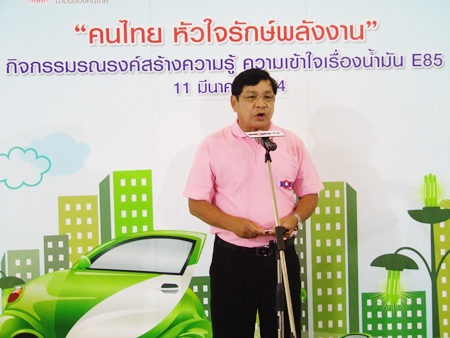With only 11 service stations offering 85 percent ethanol-gasoline more than two years after its introduction, officials from Thailand’s Energy Ministry made Pattaya the latest stop in their nationwide road show to push adoption of the so-called E85.
Ministry alternative fuels chief Krairit Nilkhuha and Rattanachai Sutidechanai, chairman of the Pattaya City Council’s Tourism & Sports Committee hyped the advantages of E85 at the March 11 “Thai Heart for Energy Conservation” exhibit at Central Festival Pattaya Beach.
Krairit said widespread adoption of the “flex-fuel” would reduce Thailand’s dependence on oil imports and the impacts of global warming while offering drivers better octane equivalents than more-popular 20 percent ethanol-gasoline mixes.
 Krairit Nilkhuha, director-general of the Department of Alternative Energy and Energy Conservation, Ministry of Energy.
Krairit Nilkhuha, director-general of the Department of Alternative Energy and Energy Conservation, Ministry of Energy.
Both E20 and E85 – made with ethanol produced through distillation of sugar cane and cassava – were introduced in Thailand in 2008. As of mid-2010, 161 E20 stations had opened with sales rising 60 percent since April 2009. By comparison, only 11 stations nationwide currently sell E85, due largely to the fact engines have to be specially designed to run E85 while most cars sold since 2009 are already E20 compatible.
None of the stations are located in the Pattaya-Sattahip area.
Hoping to turn that around, the ministry’s Department of Alternative Energy and Conservation has staged exhibits in Nakhon Ratchasima, Songkla and other provinces. Krairit believes if more people know the advantages of the high-content ethanol, more people will use it.
Topping the list of benefits is E85’s greatly reduced carbon emissions, compared with pure gasoline. E85 also offers Thailand an advantage in that 85 percent of each liter can be produced in Thailand, rather than imported, he said. Finally, E85 offers higher octane equivalents than E20 or gasoline with an 87 octane rating.
Critics, however, argue that while burning ethanol creates fewer greenhouse gases, the extra energy required to produce it negates any environmental benefit. Furthermore, while E85 may have high octane ratings, the actual energy production is 12-25 percent less by volume.
Finally, critics point out, E85 can only be used in more-expensive, high-compression modified engines and if a driver were to use straight gasoline in such an engine, it could likely cause severe damage.




